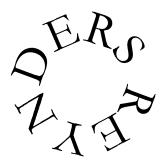

|
|
|
|
EXERCISEI was looking at Ben Sibson's "Doolicker's" article on the Djembe-L FAQ, and it reminded me of a drumming exercise in Joe Morello's book, "Master Studies" (Modern Drummer Publications, 1995/ distributed by Hal Leonard Books). Morello's exercise is intended for snare drummers to develop their single stroke rolls. It works great for hand drums, as well. Ben Sibson's Doolickers assume a steady eighth note pulse in which you change the grouping of pulses to form longer phrases. Morello's exercise assumes a steady quarter note pulse that you progressively subdivide into denser internal phrases. Start by playing a quarter note pulse through four times: 1 2 3 4 R L R L then switch (without pause) to quarter note triplets: quarters: 1...........2...........3...........4........... hands: R.......L.......R.......L.......R.......L....... next is eighth notes: quarters: 1...........2...........3...........4........... hands: R.....L.....R.....L.....R.....L.....R.....L..... then eighth note triplets: quarters: 1...........2...........3...........4........... hands: R...L...R...L...R...L...R...L...R...L...R...L... then sixteenths: quarters: 1...........2...........3...........4........... hands: R..L..R..L..R..L..R..L..R..L..R..L..R..L..R..L.. Now it gets funky: next play five beats within each quarter: (the notation changes a little here-sorry!) quarters: 1 2 3 4 hands: R L R L R L R L R L R L R L R L R L R L say: 1 2 3 4 5 2 2 3 4 5 3 2 3 4 5 4 2 3 4 5 Next, sextuplets (6 beats per quarter): quarters: 1...........2...........3...........4........... hands: R.L.R.L.R.L.R.L.R.L.R.L.R.L.R.L.R.L.R.L.R.L.R.L. Now sevens: quarters: 1 2 3 4 hands: R L R L R L R L R L R L R L R L R L R L R L R L R L R L say: 1 2 3 4 5 6 7 2 2 3 4 5 6 7 3 2 3 4 5 6 7 4 2 3 4 5 6 7 Next, eight beats per quarter (32nd notes). That's the same as counting four strokes on your right hand and filling in between each number with your left: quarter notes: 1 2 (continue on beats 3 & 4) hands: R L R L R L R L R L R L R L R L say: 1 + 2 + 3 + 4 + 1 + 2 + 3 + 4 + Next, a nine stroke roll (three groups of three) : quarters: 1 2 (etc.) hands/vox: R L R L R L R L R L R L R L R L R L say: 1 + a 2 + a 3 + a 1 + a 2 + a 3 + a Next, a ten stroke roll. Think five strokes with your right hand, filled with left strokes: quarter notes: 1 (continue on beats 2,3,4) hands: R L R L R L R L R L say: 1 + 2 + 3 + 4 + 5 + Next, eleven stroke roll. This one is the toughest. You can think of it as four doubled plus three singles: quarter notes: 1 2 (Etc.) hands: R L R L R L R L R L R L R L R L R L R L R L say: 1 + 2 + 3 + 4 + 1 2 3 1 + 2 + 3 + 4 + 1 2 3 Last is the twelve stroke roll. This one's easy (!) - count six in the right hand and fill with the left:
quarters: 1...........2...........3...........4........... hands: RLRLRLRLRLRLRLRLRLRLRLRLRLRLRLRLRLRLRLRLRLRLRLRL Morello suggests playing the strokes that fall on the quarter note beats accented. Try a slap to start each phrase. You'll see that, on the odd number phrases, the slaps switch hands on the beat. Morello says aim for even and steady timing, building towards playing the phrases unaccented. What you want is a steady "purring" sound on the faster rolls (you know, like Mamady Keita sounds!). Once again, that's: quarter notes quarter note triplets eighth notes eighth note triplets sixteenth notes five stroke rolls six stroke rolls seven stroke rolls eight stroke rolls nine stroke rolls ten stroke rolls eleven stroke rolls twelve stroke rolls Play it with a metronome, and take it very slow at first. Try and make the transitions smooth. Build speed slowly. Now, if you want to try this workout at more realistic African tempos, just do up through six stroke rolls (or eights, if you're really fast!).
|